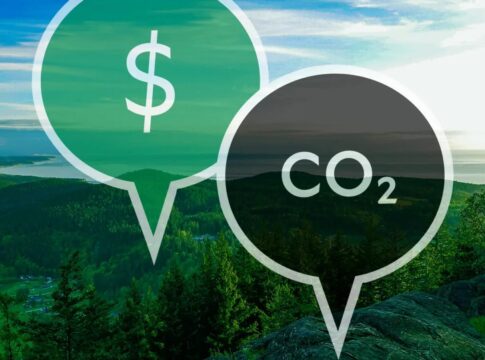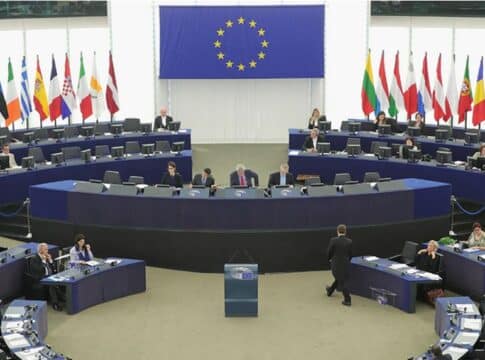Carbon Pricing Explained: How Carbon Credits, Carbon Offsets and Taxes are Priced
Between talk of carbon credits, carbon offsets, and of course carbon emissions, it can feel like carbon is everywhere. But unless you understand carbon pricing, you’ll never understand how – and why – carbon markets work the way they do.
Let’s break down carbon pricing, starting with a simple question: why put a price on carbon at all?
Carbon Pricing Basics
There’s a real-world cost to carbon emissions. The various carbon pricing mechanisms exist to identify that price and (in some cases) to create a carbon market.
The problem lies in measuring carbon pollution and identifying the resulting environmental damage, much of which is tied only indirectly to carbon dioxide emissions.
Different carbon pricing instruments estimate the cost of carbon in slightly different ways. Most of the major carbon pricing tools also handle carbon revenues differently.
Estimating the Cost of Carbon Emissions
Beginning from 2010 to 2019, the average annual global GHG emissions were at their highest historical levels, as shown below.
The impact of human-caused CO2 emissions and other GHG emissions is widespread and varied. From global warming to shifting weather patterns, GHG emissions have a lasting negative impact on the environment.
In turn, those changes have knock-on effects, including:
Crop damage
Increased risk of fire and weather-related natural disasters
Heat waves and associated healthcare costs
Rising sea levels and increased risk of flooding
The key takeaway? Putting a price on carbon emissions forces people and companies to emit less carbon, assigning a real-world value to the social cost of CO2 emissions.
The Major Methods of Carbon Pricing
The goal of pricing carbon is to force entities to produce less CO2 and other greenhouse gas emissions (GHG). Most people agree on that point; the disagreement comes over which method of carbon pricing achieves that goal the best.
There are two primary carbon pricing instruments, along with several other secondary ones.
Primary Carbon Pricing Mechanisms
Carbon Tax
Governments love taxes. They bring in revenue, they’re easy to understand, and at least in theory, they’re easy to administer. Taxes are also a great control mechanism.
Increase the taxes on something, and you increase the price; increase the price, and fewer people will be able to purchase that item or use that service.
This idea isn’t new; it’s the same principle behind the so-called “sin tax.” Increase the tax on alcohol and cigarettes and you can, in theory, reduce the number of people who use them.
The “sin” idea came to be applied more generally to practices that have a negative social cost. For cigarettes, that’s an increased burden on the healthcare system; for alcohol, there’s disorderly conduct, healthcare costs, and even drunk-driving incidents.
Applying the same concept to carbon pricing initiatives makes sense. Carbon emission, for all the reasons listed earlier, has similar social costs.
By taxing the institutions that emit CO2, governments can reduce those negative impacts while also providing a revenue stream.
A carbon tax isn’t perfect. As a pricing mechanism, it’s fixed; adjusting a tax rate is a laborious and time-consuming process. And there’s no real way to respond to market demand.
Emissions Trading System
Building a system for trading CO2 emissions establishes a rudimentary carbon market. The market can set the price, at least within certain constraints.
At the same time, an ETS allows regulatory bodies to create a baseline price that increases over time – incentivizing decarbonization.
There are at least two basic approaches to an ETS. A cap-and-trade program sets an upper emissions limit and assigns carbon credits for emissions within those limits.
Companies that don’t use up all their emissions credits can trade their excess credits to other companies that would otherwise exceed the limit.
Baseline credit systems use a similar process in reverse. Carbon credits are dispersed only to companies that keep their emissions below a set baseline. Those credits can then be traded with companies that are above the baseline.
Other Carbon Pricing Mechanisms
In addition to a carbon tax and an emissions trading system, there are a number of carbon pricing mechanisms that tend to gather a bit less attention.
Internal Carbon Pricing
When companies calculate their own price for carbon emissions and build that into their planning, that’s an internal pricing mechanism. Internal carbon pricing provides the greatest flexibility for companies, but can also be the hardest to clarify or define.
Some recent initiatives, such as the Science-Based Targets initiative (SBTi) seek to provide some third-party guidance on this process.
In setting an internal carbon price, there’s a range of points to consider. It includes reviewing external risks and looking into the carbon tax risks in operating countries, where there can be variations.
The most important starting point if you’re considering internal carbon pricing is to understand your own business drivers for setting it.
Results-Based Climate Funding (RBCF)
Typically funded by various regulatory agencies or even non-governmental organizations, RCBF offers payments when certain emissions reductions have been reached.
By focusing on results that create incentives to take action – from planting trees to improving access to clean energy, RCBF can help cut emissions.
But for all its utility, this mechanism has been a complicated tool to use, putting off many would-be users.
There’s a final method of carbon pricing that’s worth mentioning, having quickly become a multi-million-dollar market globally: offsetting.
Carbon Offsetting as a Pricing Mechanism
Carbon offsetting embraces a free-market approach to the carbon pricing problem. CO2 emissions are calculated by a tonne of C02, but offsets are given for preventing or removing CO2 emissions.
For example, planting a forest allows trees to absorb CO2 into their trunks; building a Carbon Capture and Storage (CCS) facility can pull CO2 straight from a factory’s exhaust and lock it away before it has a chance to enter the atmosphere.
Projects calculate the value of these offsets and then sell them on the open market to other companies who want to cover some of their own emissions.
If every tonne of CO2 produced by an entity is covered by an offset, then in theory the net result would be zero emissions – what is commonly referred to as a “net zero” position.
Carbon offsetting lacks the regulatory oversight and control of some of the other approaches to carbon pricing, such as government-run carbon policies.
But in exchange, it provides a wide range of flexibility. Carbon offset projects can be highly technical CCS programs or focused on natural approaches, such as restoring natural carbon sinks like forests and peat bogs.
Keys to a Successful Pricing Mechanism
Setting carbon prices that work requires a few key ingredients. Carbon pricing policies need to achieve the primary goal of reducing emissions.
And to do that, they generally require the following elements:
Justice – This is the “polluter pays” principle. The guilty party bears a monetary cost for the negative social cost of their practices.
Transparency – Any attempt to price carbon fairly needs to be open and transparent, making clear how the carbon price is calculated.
Alignment – Carbon pricing works best as part of a broader approach to the climate challenge. Enacting an internal price on carbon, then doing little or nothing to prevent water pollution, for example, casts doubt on the entire process.
Efficiency – Effective carbon pricing systems include ways to ensure compliance, pushing entities to reduce CO2 emissions over time.
Challenges for Carbon Pricing Systems
Each of the carbon price mechanisms mentioned above brings its own unique problems, but there are at least three broader issues to consider.
Leakage – Imposing a high price on carbon helps reduce CO2 emissions, but a poorly-designed program can lead to leakage when industries move production to other, less-regulated locations and end up producing more CO2 down the line.
This is the phenomenon known as “carbon leakage.” To avoid leakage, planners need to consider CO2 emissions at the meta-level, looking beyond a particular company or region.
Inefficiency – The implementation of a carbon price makes all the difference to long-term success. Great but poorly executed plans result in leakage, missed reductions, and a host of related issues regardless of the types of carbon pricing used.
Mismanagement – A good carbon pricing scheme generates revenue – but if that revenue isn’t used to reduce future emissions, then the entire program has missed the point.
Examples of Successful Carbon Pricing Mechanisms
A number of successful carbon pricing mechanisms are in use around the world already; here are three of the most notable.
EU ETS
The European Union’s Emissions Trading Scheme is a variation on a cap-and-trade program. It’s currently the largest carbon market, and a key part of the EU’s plan to tackle greenhouse gas emissions.
The EU ETS applies the same principle as most regulatory carbon markets, using a slowly reducing cap on emissions to force companies to gradually reduce carbon output. The market covered over 1.2 billion tonnes of CO2e in 2021.
California’s Cap-and-Trade
Regulated by California’s Air Resources Board (CARB), California’s cap-and-trade program is one of the only ones of its kind in the United States. It’s also one of the largest in the world, applying to several industrial sectors in California’s booming economy.
Power generation and fuel supply both come under the cap-and-trade program. The program began in 2013 and has already achieved noteworthy goals such as the reduction of GHG emissions to 1990 levels.
Voluntary Carbon Market
The voluntary carbon market (VCM) takes a different approach, employing a carbon offsetting mechanism. This expands the VCM beyond national jurisdictions, opening the door for a booming trade in carbon offsets from a variety of sources.
In particular, renewable energy, clean technology, carbon capture, and nature-based carbon sequestration are just some of the methods for creating carbon offsets.
There’s no internal carbon price in the VCM; instead, trade establishes a market price that varies from location to location and sector to sector.
The VCM: Setting the Standard for Carbon Pricing Programs
A good carbon pricing system makes the external costs of CO2 emissions clear and easy to see for businesses and corporations.
The VCM takes that idea one step further, opening the door for private individuals to participate directly in a global carbon market.
Individuals can purchase carbon offsets directly, creating a sort of personalized internal carbon price. They can also tailor their approach to the market depending on what they see as the most important impacts of climate change.
Even billionaires themselves have pumped millions of dollars of their personal money into the VCM. Their valuable investments helped fuel more market growth and inspire carbon removal startups to scale up and suck in more carbon from the air.
The greatest advantage of the VCM is the ability for companies and individuals to see the impact of carbon pricing directly.
For instance, offsets purchased on the VCM can regrow forests, push cutting-edge CCS technologies, and even support local rewilding efforts.
It’s for that reason and others that the VCM continues to grow at a breath-taking pace.
The post Carbon Pricing Explained: How Carbon Credits, Carbon Offsets and Taxes are Priced appeared first on Carbon Credits.



